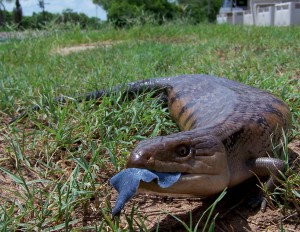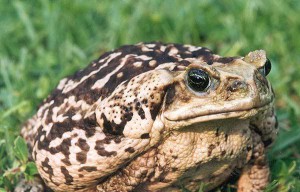 In tropical climates, bluetongue lizards seek oases of cool in order to avoid overheating finds research published in Animal Biotelemetry this week. Unlike their cool-climate cousins, whose behavioral thermoregulation is determined by seeking heat, the diurnal bluetongue lizards of northwestern Australia can only survive where they can use shady refuges of dense vegetation to cool down. And this comes with a warning – these areas are also favoured by toxic cane toads, which threaten the conservation of this species.
In tropical climates, bluetongue lizards seek oases of cool in order to avoid overheating finds research published in Animal Biotelemetry this week. Unlike their cool-climate cousins, whose behavioral thermoregulation is determined by seeking heat, the diurnal bluetongue lizards of northwestern Australia can only survive where they can use shady refuges of dense vegetation to cool down. And this comes with a warning – these areas are also favoured by toxic cane toads, which threaten the conservation of this species. 
By attaching GPS devices to 49 bluetongue lizards (Tiliqua, Scincidae) and radio tracking their movements for up to 221 days, researchers at the University of Sydney have identified critically important features of the habitat use. They showed that the lizards use small scattered patches of land, which were cooler, damper and had denser vegetation than the surrounding area for their core daily activity. They spent an average of 95% of their time in these areas, in order to avoid lethally high temperatures experienced in more exposed areas in their home range.
This work, from the lab of Rick Shine, a leading expert in the invasion of the cane toad in Australia, is of two-fold importance for conservation of the bluetongue lizards. Firstly, by identifying these crucial habitat features, future conservation efforts can aim to preserve the landscape heterogeneity at the necessary spatial level to allow movement between patches. Secondly, this identifies a worrying overlap in land use between the blue-tongue lizards and the cane toads, which are lethally toxic to these reptiles.
 It is important for the conservation of these species that these areas are maintained, and that invading cane toad populations are monitored and controlled in order to mitigate for the effects of this unfortunate overlap in habitat use.
It is important for the conservation of these species that these areas are maintained, and that invading cane toad populations are monitored and controlled in order to mitigate for the effects of this unfortunate overlap in habitat use.
Shine explains: “effective conservation of our threatened wildlife depends upon a clear understanding of how animals use the landscape. The increasing miniaturisation of GPS telemetry packages means that, for the first time, we can deploy these units on smaller animals like lizards – and as a result, we can obtain a vastly more detailed picture of the resources upon which they depend”.
Blue tongue lizard image credit: Travis Child
Cane toad image from: https://commons.wikimedia.org/wiki/File:Cane-toad.jpg
Comments